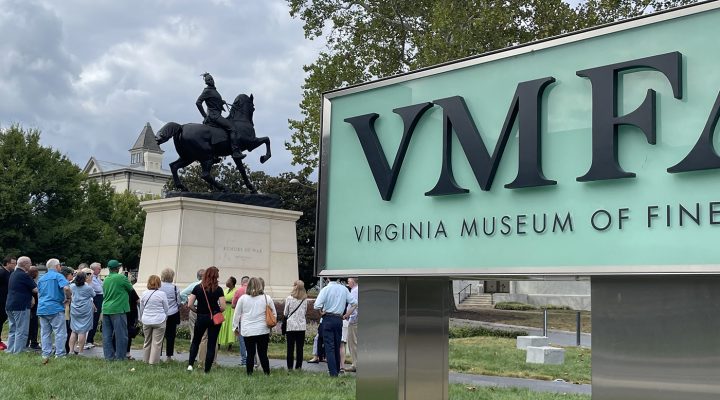The morning exploration of a long-hidden slave processing site in downtown Richmond, Va., was so overpowering for Kan’Dace Brock that she had to be comforted by others touring the Lumpkin’s Slave Jail and historic burial ground.
Walking the location where Africans were imported, held, auctioned and often executed during the 18th and 19th centuries was overwhelming, she said. Seeing how the tract had been paved over to sanitize that history was equally difficult, she added.
“I just broke down. You learn so much about humanity in these stories,” said Brock, lead pastor of The Message Church in San Antonio, Texas. “To go from Lumpkin’s Jail to a parking lot to a huge open field is indicative of how America views Black bodies today — just pave over them.”
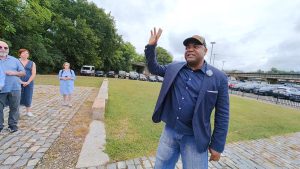
Dontrese Brown speaks to the BNG group at the beginning of the tour, near a remaining parking lot.
Brock was one of more than 20 participants of Baptist News Global’s Colonial Williamsburg and Richmond educational event, held Sept. 7-8. Tours and lectures in both cities were aimed at illuminating the long-hidden history of racism in Colonial America that set the stage for racial discrimination for decades and centuries to come.
In Richmond, tour members consisting of ministers and laypeople, BNG staff and board members from around the country began at the slave jail before moving to the location of the now-removed Civil War equestrian statue of Robert E. Lee, and finally on to the Virginia Museum of Fine Arts for a presentation about the pain and struggle captured by African American artists. Along the way they visited Historic St. John Episcopal Church where Patrick Henry made his plea, “Give me liberty or give me death,” in 1775.
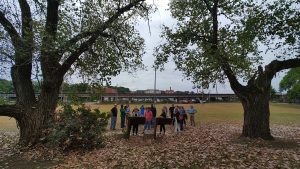
Gallows were erected between the two trees to hang Africans who were brought to Richmond but not sold at market.
But Lumpkin’s Slave Jail, located on what also was known as the Devil’s Half Acre, had to be the starting point, said Dontrese Brown, guide for the morning portion of the tour.
“This is the spot that has the most pain and the most suffering,” said Brown, founder and CEO of Hidden in Plain Site: Richmond, a nonprofit that uncovers and recreates long-hidden slave sites through computer and virtual-reality tours in the city.
The Devil’s Half Acre, where the online tours also begin, is where captured Africans, having just disembarked from slave ships docked at the nearby James River, were led to be jailed before they were marched in shackles to a nearby auction block on market days. They were sold alongside all manner of other household commerce and groceries.
The Hidden in Plain Site online and virtual-reality tours recreate the structures that once stood on the site and march participants along the route slaves took to their ultimate fates — either to be sold, jailed or hanged.
 “We want you to really feel what that was really like,” he said as the group walked solemnly through a tunnel and toward a grassy field that still bears the evenly spaced light poles from its recent days as a parking lot.
“We want you to really feel what that was really like,” he said as the group walked solemnly through a tunnel and toward a grassy field that still bears the evenly spaced light poles from its recent days as a parking lot.
He offered evocative descriptions for the in-person BNG group. “This was the largest slave jail in the United States, second only to New Orleans,” he explained. “It was an underground jail. It was the worst place. They kept the slaves until they went to market. They were either sold, or they were hanged.”
He pointed to the vast parking lot-turned-grass field to show where the executed were interred over many years: “You are standing on a burial ground for the Negros in the City of Richmond.”
Many of those bodies were removed and reburied in mass graves — stacked up to 100 deep — to make way for the construction of the interstates, he added. “The lack of appreciation for life is very powerful.”
But the injuries inflicted on enslaved people continued beyond the slave era as structures like Lumpkin’s Jail were torn down and covered over to ensure the atrocities committed there were forgotten.
Brown noted that hundreds of thousands of oblivious commuters pass this site daily on Interstates 64 and 95, and on the local railway system, located just feet away. Motorists who park in a nearby lot, mainly students at the VCU Medical School, do so without knowing they are in Devil’s Half Acre.
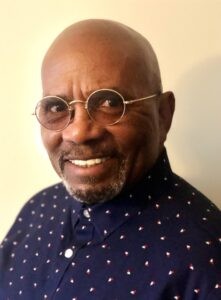
Aidsand Wright-Riggins
BNG board member Aidsand Wright-Riggins counted himself among the oblivious. He completed a doctorate in ministry in 2005 at the Samuel DeWitt Proctor School of Theology at Virginia Union University, a historically Black institution less than 3 miles from the site — and he never heard of the slave jail, gallows auction area and graveyard.
“What strikes me is how, then or now, people are so easily paved over.”
“What strikes me is how, then or now, people are so easily paved over. Even today, the need for crucial conversation is being paved over,” said Wright-Riggins, executive director emeritus of the American Baptist Home Mission Societies, mayor of the Borough of Collegeville, Pa., and leader of the New Baptist Covenant.
He added that the tour was especially powerful to him because his slave ancestors had come into the nation through Richmond. “That’s why this is sacred ground to me.”
The next stop for the tour was one that Brown said offered more hope than horror: the roundabout where a 60-foot Robert E. Lee monument was taken down in 2021.
Brown noted that the site on Monument Avenue — like the statues of J.E.B. Stuart, Stonewall Jackson, Jefferson Davis, Matthew Fontaine Maury removed in 2020 — were sacred ground for whites who honor the Confederacy.
The installment of the monuments in the late 19th and early 20th centuries was celebrated by whites and led to a housing boom that also drew white churches to the area. But now, Brown said, all four monuments are owned by the Black History Museum and Cultural Center of Virginia as the future use of their former locations is determined. The only remaining statue is one depicting Black tennis player Arthur Ashe, which was erected in 1996.
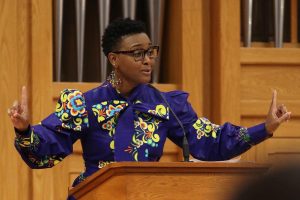
Kan’Dace Brock
Brock, the Texas pastor, said it was an eerie feeling to stand on Monument Avenue after having watched the removal of the Lee statue on television. Knowing the site’s significance to American racism also was powerful.
“What was so ironic to me is the graffiti: ‘I can’t breathe’ and ‘Black lives matter,’” she said of those and other slogans spray painted on the concrete ring that borders the parcel.
Also ironic, Brock added, was the later viewing of the immense “Rumors of War” monument outside the Virginia Museum of Fine Arts on Arthur Ashe Boulevard. Designed to mirror the now-removed statue of J.E.B. Stuart, the sculpture by Kehinde Wiley depicts a young Black man in street clothes riding a rearing horse.
“Rumors of War” was installed in 2019 to push back against the inherent message of the Civil War monuments, VFMA curator Valerie Oliver said. “The tropes of war need a response.”
That response hit home for Brock. “It was so courageous and positive. It has such an encouraging theme — especially after the (Lumpkin’s) jail experience in the morning.”

The BNG tour concluded with a Q&A session at First Baptist Church in Richmond with BK Fulton, a Richmond-based film and Broadway play producer and financier, author and corporate leader who discussed how contributions of African Americans have been historically ignored.
As an example, Fulton cited African American Lewis Latimer, whose invention of the filament enabled Thomas Edison to invent the light bulb. “Thomas Edison couldn’t have succeeded without Lewis Latimer, but we leave that part out because people who look like me came here in chains,” he said.
Truth, Fulton added, is seeing the fullness of such histories to understand that whites have more in common with Blacks than they may think. “We are all cousins trying to find our way home. We are more similar than different. We just focus on the differences because we don’t know all of our stories.”
Related articles:
Whether blind, blurry or oblivious, failure to see whiteness distorts God’s image in others

